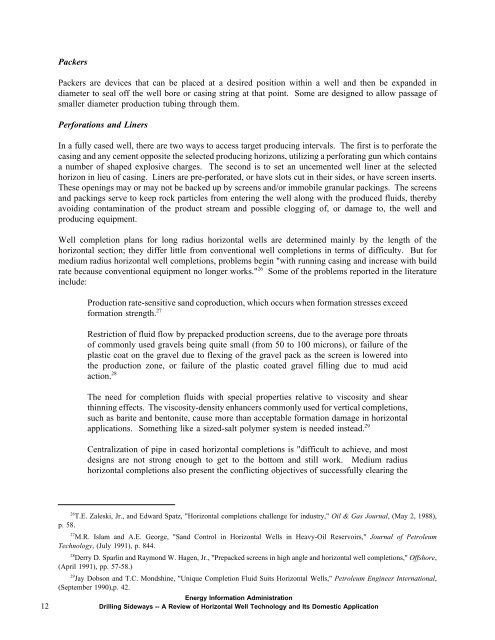Drilling Sideways -- A Review of Horizontal Well Technology ... - EIA
Drilling Sideways -- A Review of Horizontal Well Technology ... - EIA
Drilling Sideways -- A Review of Horizontal Well Technology ... - EIA
You also want an ePaper? Increase the reach of your titles
YUMPU automatically turns print PDFs into web optimized ePapers that Google loves.
Packers<br />
Packers are devices that can be placed at a desired position within a well and then be expanded in<br />
diameter to seal <strong>of</strong>f the well bore or casing string at that point. Some are designed to allow passage <strong>of</strong><br />
smaller diameter production tubing through them.<br />
Perforations and Liners<br />
In a fully cased well, there are two ways to access target producing intervals. The first is to perforate the<br />
casing and any cement opposite the selected producing horizons, utilizing a perforating gun which contains<br />
a number <strong>of</strong> shaped explosive charges. The second is to set an uncemented well liner at the selected<br />
horizon in lieu <strong>of</strong> casing. Liners are pre-perforated, or have slots cut in their sides, or have screen inserts.<br />
These openings may or may not be backed up by screens and/or immobile granular packings. The screens<br />
and packings serve to keep rock particles from entering the well along with the produced fluids, thereby<br />
avoiding contamination <strong>of</strong> the product stream and possible clogging <strong>of</strong>, or damage to, the well and<br />
producing equipment.<br />
<strong>Well</strong> completion plans for long radius horizontal wells are determined mainly by the length <strong>of</strong> the<br />
horizontal section; they differ little from conventional well completions in terms <strong>of</strong> difficulty. But for<br />
medium radius horizontal well completions, problems begin "with running casing and increase with build<br />
rate because conventional equipment no longer works." 26 Some <strong>of</strong> the problems reported in the literature<br />
include:<br />
Production rate-sensitive sand coproduction, which occurs when formation stresses exceed<br />
formation strength. 27<br />
Restriction <strong>of</strong> fluid flow by prepacked production screens, due to the average pore throats<br />
<strong>of</strong> commonly used gravels being quite small (from 50 to 100 microns), or failure <strong>of</strong> the<br />
plastic coat on the gravel due to flexing <strong>of</strong> the gravel pack as the screen is lowered into<br />
the production zone, or failure <strong>of</strong> the plastic coated gravel filling due to mud acid<br />
action. 28<br />
The need for completion fluids with special properties relative to viscosity and shear<br />
thinning effects. The viscosity-density enhancers commonly used for vertical completions,<br />
such as barite and bentonite, cause more than acceptable formation damage in horizontal<br />
applications. Something like a sized-salt polymer system is needed instead. 29<br />
Centralization <strong>of</strong> pipe in cased horizontal completions is "difficult to achieve, and most<br />
designs are not strong enough to get to the bottom and still work. Medium radius<br />
horizontal completions also present the conflicting objectives <strong>of</strong> successfully clearing the<br />
26<br />
T.E. Zaleski, Jr., and Edward Spatz, "<strong>Horizontal</strong> completions challenge for industry," Oil & Gas Journal, (May 2, 1988),<br />
p. 58.<br />
27<br />
M.R. Islam and A.E. George, "Sand Control in <strong>Horizontal</strong> <strong>Well</strong>s in Heavy-Oil Reservoirs," Journal <strong>of</strong> Petroleum<br />
<strong>Technology</strong>, (July 1991), p. 844.<br />
28<br />
Derry D. Sparlin and Raymond W. Hagen, Jr., "Prepacked screens in high angle and horizontal well completions," Offshore,<br />
(April 1991), pp. 57-58.)<br />
29<br />
Jay Dobson and T.C. Mondshine, "Unique Completion Fluid Suits <strong>Horizontal</strong> <strong>Well</strong>s," Petroleum Engineer International,<br />
(September 1990),p. 42.<br />
Energy Information Administration<br />
12 <strong>Drilling</strong> <strong>Sideways</strong> -- A <strong>Review</strong> <strong>of</strong> <strong>Horizontal</strong> <strong>Well</strong> <strong>Technology</strong> and Its Domestic Application

















